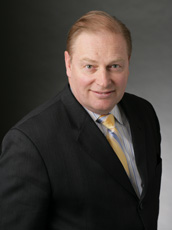Two years after superstorm Sandy inflicted unprecedented damage on NYU Langone Medical Center in New York City, Michael Burke, the system's senior vice president, vice dean and corporate CFO, had already guided the organization through a financial turnaround and returned the system to profitability.
With more than 20 years of healthcare finance experience, Mr. Burke understands the challenges of being a health system CFO and what it takes to keep an organization profitable, which is something he has demonstrated since joining NYU Langone Medical Center in 2008. When Mr. Burke came to NYU Langone Medical Center he wasn't new to the CFO role as he had previously served as senior vice president and CFO at Tufts Medical Center in Boston, a position he began in 2004.
Question: Wh at are some of the best practices for running the finance team of a hospital or health system?
at are some of the best practices for running the finance team of a hospital or health system?
Michael Burke: A best of class finance function has to have robust financial systems to be successful, including an integrated enterprise resource planning (ERP)system to process all expense transactions and an integrated billing and electronic clinical documentation system. Such systems enable automated work flows to process transactions and conduct analysis, thereby reducing the amount of time needed to be spent on checking and correcting errors. Additionally, such systems provide a robust decision support system that marries the revenue cycle data with the general ledger cost data using cost accounting techniques at the patient level. As a result, finance can instead spend the majority of its time analyzing the business trends and providing financial analysis to business partners about their operations versus budgets and benchmarks.
Q: What is the greatest challenge facing hospital and health system CFOs today?
MB: The greatest challenge is managing risk and the uncertain future of the revenue streams that we have all grown accustomed to over the years. As we move from a system where we get paid for providing treatment and conducting procedures, including surgery, to a system that reimburses for improving health outcomes and wellness, you have to make sure there is still enough revenue to maintain margins and pay off debt. You also need to ensure you have the systems required to measure and monitor the risk you are taking, which is no small task.
Q: In the last year, what has been your greatest accomplishment as CFO?
MB: Maintaining our bond rating while we issued new debt to complete our campus transformation plan and improving our liquidity and returning the organization to profitability is something we are proud of. However, one of our biggest accomplishments was returning our organization to profitability in less than two years after superstorm Sandy inflicted unprecedented damage on NYU Langone Medical Center. I would have to say that was by far our greatest accomplishment.
Q: From a financial standpoint, what goes into preparing for capital projects?
With capital projects you have to make sure there is a return on investment (ROI) that exceeds your weighted average cost of capital and that the return justifies the expense. If there is no ROI, but it is replacing infrastructure or programs that are mission critical, you need to make sure it is done out of the operating cash flow available for capital each year.
Q: What is one goal you have for the next year and how will you achieve it?
MB: Our current fiscal year goal was to improve profitability and reduce costs through the value based management program. In 2015 it will be to complete the merger of another health system into our corporate infrastructure and help it improve its operating margin and pay for the much needed investments in that campus.
More articles on healthcare finance:
Arkansas governor wants alternative to Medicaid expansion to continue
$154M in Sandy relief to go to South Nassau Communities Hospital

